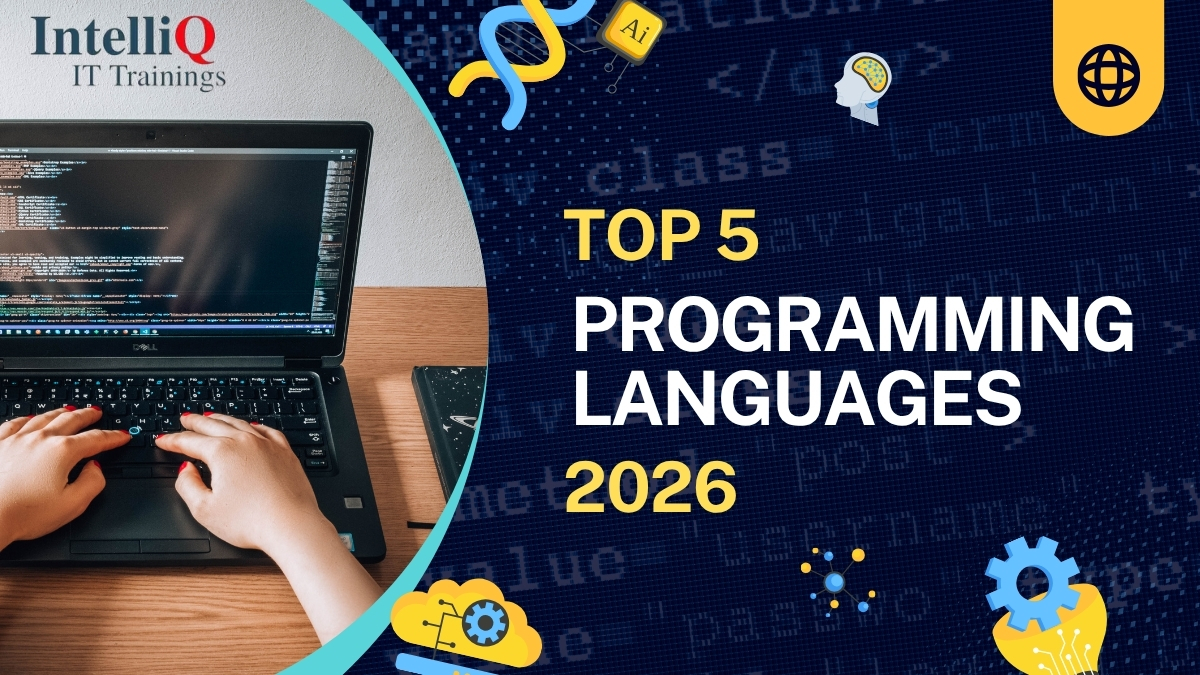Introduction:
The technological world is still changing at a blistering pace, and the programming field is at the center of the change. Coding will stop being a developer-only product in the year 2026 and become an essential skill that every person who wants to succeed in the digital economy possesses. The ability to write code makes students innovate, automate and find a solution to a problem on the ground, whether through artificial intelligence, or by creating an app. It is important to make the correct choice in the programming language to develop a robust foundation. This paper discusses the five best programming languages that every student must master in the year 2026 to remain at the top.
1. Python: The King of Simplicity and Power
Why Python Still Leads:
Python has remained the leading programming language because of its high readability, simplicity, and versatility. It is a language that is easy to learn and does not reduce the power. The simple syntax of Python enables the student to concentrate on the logic but not on the complicated code structure, hence it is best suited to novice programmers. It is commonly applied in web development, data science, automation, artificial intelligence and cybersecurity. Python is extraordinarily valuable to the industrial sector, as demonstrated by the use of the programming language in educational institutions and tech giants such as Google and NASA.
Applications of Python in 2026
Python will keep forming the foundation of data-driven industries in 2026. As AI, machine learning, and big data analytics develop, Python offers libraries and frameworks such as TensorFlow, Pandas, and NumPy, without which innovation cannot exist. Students who are learning Python can have a practical knowledge of tools that are applied in the professional world. Python can be used to create chatbots as well as automate processes, both of which have infinite possibilities owing to its flexibility. It is a future-proof option for any future programmer because of its compatibility with new technologies such as IoT and blockchain.
Why Students Should Learn Python
Python helps the students experiment, create and innovate without entangling themselves in syntax complications. It has a large community and a lot of documentation, which guarantees that it can support learners at all times. Besides, Python is commonly used as a first language in computer science courses because it is simple and yet functional. Students who learn Python acquire transferable coding skills that are applicable in other languages and frameworks. Concisely, Python is not simply a piece of programming technology but rather the door into the system of how technology can be used in our lives today.
2. JavaScript: The Language of the Web
The Ubiquity of JavaScript:
JavaScript is the language that all web developers need to know about, in case there is such. Just about any internet site and web application is based upon it. JavaScript is also critical in developing dynamic interactive user experience as front-end technologies continue to develop. Using frameworks such as React, Angular, and Vue.js, a web developer is able to create responsive web applications with ease. JavaScript does not rely on the Internet anymore, as in 2026, it will be able to drive mobile applications, servers, and even IoT through Node.js, which confirms its unparalleled flexibility in the programming world.
How JavaScript Shapes Modern Applications:
JavaScript cannot be done without in modern web development. Students studying this language find it very easy to move to the front-end, back-end or full-stack positions. JavaScript enables the client to interact with the server side smoothly using tools such as Node.js, Express and Next.js. In addition, JavaScript is becoming more efficient through the creation of new structures and AI-powered development tools. The need for JavaScript developers will keep increasing even in 2026 as companies will be investing in the production of digital products, web portals, and cross-platform applications.
Why JavaScript Is a Must for Students:
JavaScript is very interactive and can be used by more creative learners who like working with visual and hands-on code. It allows students to view the outcomes of their work as soon as possible in browsers, which stimulates experimentation and lifelong learning. It has a large developer community, which offers access to tutorials, open-source projects and working together. JavaScript also allows entry to full-stack development when combined with such technologies as MongoDB and Express. Concisely, learning JavaScript provides learners with an edge in web and application development professions.

3. Java: The Foundation of Enterprise Applications
Why Java Remains Relevant:
Java has been one of the oldest programming languages used in enterprise and Android applications development even today. It is used by large-scale software systems because of its stability, scale and platform independence. Java has remained dominant in banking, e-commerce, and cloud computing industries in the year 2026. Its philosophy of write once, run anywhere makes its application based on Java portable and reliable. The learners get a good knowledge of object-oriented programming, which is the foundation of most modern languages.
Java Roles in Enterprise and Cloud:
Java has been the backbone of enterprise solutions for a long time and especially in Spring Boot and Microservices architectures, it is the major platform. When companies are moving to the cloud, they look for Java developers to create and sustain their strong applications and Java support on platforms such as AWS and Azure is huge. Also, the development of Android continues to be mainly based on Java, though Kotlin has become more popular. The knowledge of Java adds to the student’s skills in enterprise systems, mobile development, and backend services.
Why Students Learn Java:
Java possesses unmatched career prospects for students who are interested in developing a professional career in software engineering. It instructs fundamental concepts of programming such as inheritance, polymorphism and encapsulation, which are essential in all coding languages. Java has a large library of libraries, programs, and frameworks that assist designers in developing effective and secure applications. On top of this, it is a portal to the learning of related technologies such as Kotlin, Scala, and Groovy. Java has been a solid base of success in long-term software development in 2026.
4. C++: The Powerhouse of Microsoft Technologies
The Role of C++in 2026:
C++ has gone way beyond its intended to be a Microsoft-only language. It is used today to run web, desktop and mobile applications using the .NET framework. C++ will be able to flourish as an effective and designed language that is best suited to game creation, enterprise software, and cloud computing in 2026. C++ has also been made platform-independent with the investment by Microsoft in open-source technologies with .NET Core, allowing developers to develop apps to run on Windows, macOS, and Linux environments without any issues.
C++and Game Development:
The main language of Unity, which is one of the most popular gaming engines in the world, is used in game development in C++. C++ can be used to make students interested in developing 2D, 3D, or AR/VR games to make their creative visions true to life. Outside of gaming, it is also common in fintech, medical and automation systems in enterprises. It is not hard to write efficient code because of its clean syntax and great features, including asynchronous programming, LINQ, etc. C++ provides students with equal amounts of stability and innovation.
Why Students Should Choose C++:
C++ gives a powerful introduction to object-oriented programming and current code. It suits those students who want to work in the sphere of game development, software engineering or in Microsoft technologies. The flexibility and combination with Visual Studio make the process of development and debugging easier. The demand will remain high in 2026 when mixed reality and cloud-based applications are more widespread, and C++developers can still be recruited to work. C++is a smart and future-ready option to learners who also require creativity and structure at the same time.
5. Go (Golang): The Future of Cloud and Scalability
Introduction to Go:
Google created Go, also known as Golang, a very popular language among developers of scalable cloud-based applications and distributed systems. It has clean syntax, is easy and offers high performance to fit in a modern computing environment. By the year 2026, there will still be cloud platforms, microservices, and DevOps tools built on Go. It has inbuilt concurrency services that enable its developers to concurrently manage many processes efficiently, which makes it suitable for performance-oriented applications. A large number of leading companies that create large-scale systems use Go.
Go in the Cloud-Native World:
The design of Go is efficient, and is concurrent, and simple, which is invaluable in the cloud computing environment. Popular cloud systems as Kubernetes and Docker, are also developed in Go, which provides evidence of the reliability and scalability of this language. In 2026, Go students will be entering one of the fastest emerging fields, the cloud engineering and DevOps industry. This is because it is lightweight and therefore will perform optimally, even in resource-limited environments. Learning Go prepares the students with the ability to work on the next-generation tools that facilitate automation, artificial intelligence and scale.
Why Students Should Learn Go:
Go provides students with an advantage to learn modern software infrastructure. It is both fast and easy to develop, as it is a combination of C++ and Python, and enables developers to create code that is easy to maintain and develop. The increased use of Go in companies and startups implies that learning it can open high-paid careers. Go will be a future-proof investment for those students who are interested in DevOps, backend systems, or cloud architecture. Its emphasis on speed, concurrency, and reliability makes it an indispensable one to study in the next decade.
6. The Emerging Role of Programming in 2026
Coding Beyond Software Development:
By the year 2026, programming will have grown beyond software development. It is currently a source of automation, data analysis, artificial intelligence, and robotics innovations. The art of coding involves learning how to solve problems, think critically and be creative, which is much more than technology. Regardless of whether the students are studying IT, engineering, finance, or design, programming improves their analytical skills and flexibility. With the further digitalisation of industries, code will be as vital as literacy and numeracy.
Choosing the Right Language for Your Goals:
Every one of the top five languages: Python, JavaScript, Java, C++ and Go has its use. Python is the best AI and data science; JavaScript is the most popular web development platform; Java is the most popular enterprise platform; C++ is all-purpose games and software; and Go is the most popular cloud computing platform. Students are supposed to make their choice depending on their learning preferences and career interests. The ability to master at least one of these languages will be a ready step towards learning others and creating a varied and flexible repertoire.
7. How to Start Learning Programming
The beginning of the programming journey is not necessarily very difficult to manage. Learners can choose between online examples, coding bootcamps, or organised courses from recognised institutions such as IntelliQ IT Trainings. Knowledge gained from books or lectures alone will not suffice, and students ought to partake in the actual application of the theory to fully understand it. Keeping in touch with other programmers through discussion boards and participation in open-source projects is also regarded as good practice for learning, If learners continue the practice and do not lose their inquisitiveness, they will definitely acquire programming skills that are required for the tech roles that will be in high demand in 2026 and even further on.
Conclusion:
The coding skills will determine who controls the future. In 2026, the correct programming languages will be the key to the infinite possibilities of AI, cloud computing, web apps, and enterprise systems. Python, JavaScript, Java, C++, and Go will be in no way technologies—they will be the gates to innovation and problem-solving, The students who invest time today to grasp these languages will be the ones to usher in the digital revolution of tomorrow. It’s essential to begin, be consistent, and continually discover the never-ending universe of programming.






